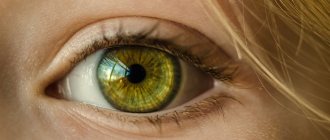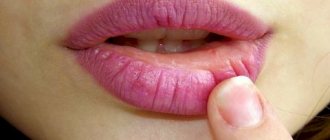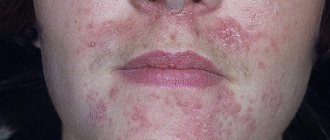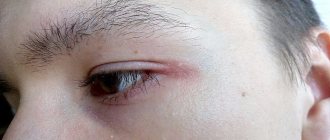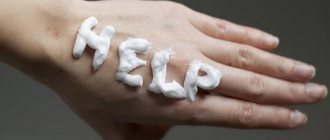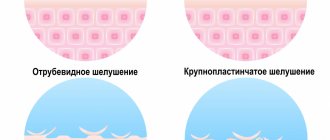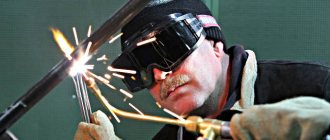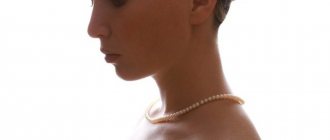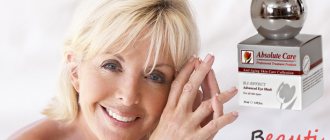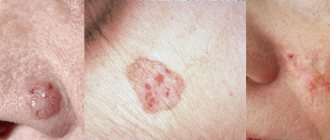Causes
The reasons can be different: external and internal. The condition of the skin around the nose can be influenced by the general condition of the body, the development of diseases, and unfavorable weather conditions that cause irritation and peeling.
Photo 1: To begin treatment that will get rid of this defect, it is necessary to determine what causes its appearance. The nature of the peeling, the location of its manifestation and the accompanying symptoms matter. Source: flickr (Rosacea Facts).
Redness and peeling on the wings of the nose
If the wings of the nose turn red and peel, the causes of this phenomenon may be:
- Regular wiping with napkins or a handkerchief. If you have a profuse runny nose, you have to wipe your nose often; from constant friction, it begins to dry out, become covered with microcracks, and turn red.
- Lack of vitamins. Vitamin deficiency usually occurs in early spring.
Causes of itching and flaking of the skin around the nose
- Incorrectly selected hygiene product: scrub, foam, soap, etc.
- Influence of weather: strong wind, frost, abnormal heat.
Causes of red spots around the nose
- Allergy. May occur after tasting an exotic fruit or contact with an animal, etc.
- Cold. With a cold, a runny nose often occurs. Excessive nasal discharge causes redness.
Why red spots don't go away
Red, swollen spots on the tip and sides of the nose can be a constant occurrence, disappearing for several hours or days and appearing again.
Constant exposure to allergens
Any allergen can be a potential irritant; an allergist will help identify it by conducting the necessary research . Associated symptoms, lacrimation, rash on the face, and burning of the mucous membrane may indicate an allergy .
Demodicosis
This is the most common cause of spots on the tip of the nose and in the mouth area. Demodex are mites that can be found in feather pillows. Treatment for this disease is usually long and complex . Almost every person has the parasite, the causative agent of demodicosis, but if symptoms of its infection appear, this indicates a decrease in the body’s defenses, therefore treatment is primarily aimed at strengthening the immune system and eliminating risk factors .
Frequent weather changes
In some cases , a “cold allergy” can be observed; this is not dangerous and the symptoms gradually go away on their own . You can protect your nose with high-quality nourishing creams, which should be applied before leaving the house in cold weather.
Fungal infection
Rash and spots on the nose with accompanying itching may indicate the development of candidiasis. In this case , the skin will peel and itch , and then you need to consult a dermatologist.
Frequent worries and stress
The skin instantly reacts to changes in lifestyle . A stressful situation can be not only an incident that caused a strong shock, but also a change in climatic conditions, nutrition, or taking certain medications.
Diseases that cause redness and flaking of the nose
Redness and flaking of the nose can be a symptom of the following diseases:
- Demodecosis is a skin infection caused by the parasite Demodex mite. This parasite is a common inhabitant of the skin. It does not cause concern, but as immunity decreases, the number of parasites increases. They destroy the epithelium and cause inflammation. There are two types of Demodex: some live in the hair follicles, and others live in the sebaceous glands. Parasites live mainly on the skin of the face.
Interesting to know! According to statistics, about 90% of the population are carriers of demodex, and one of the most common causes of demodicosis is stressful situations.
- Seborrheic dermatitis . Yeast-like fungus is a permanent inhabitant of the facial skin. It has a beneficial effect on its development. As a result of decreased immunity, the amount of fungus increases, inflammation and even ulcers occur.
Photo 2: Seborrheic dermatitis usually becomes a problem for people with oily skin. Source: flickr (Phoenix Renaissance).
- Seborrheic psoriasis . This disease begins to appear on the scalp and consists of small areas of flaking. The disease then spreads to the area behind the ears, where it appears as pustules, and to the face, where it appears as patchy, scaly rashes.
Peeling treatment
It depends on the cause of the problem and is:
| Taking medications. | More often we are talking about vitamins, but for skin diseases of bacterial origin, antibiotics can be prescribed. |
| In carrying out cosmetic procedures. | You can change the condition of your skin using salon procedures, in particular mesotherapy. Professional moisturizing masks have good results. |
| In the use of traditional medicine. | Herbs can also help eliminate skin defects; their use in combination with ointments and cosmetics gives good results. Decoctions of medicinal herbs soothe the skin and remove flaking. |
The most effective approach to solving the problem is the combined use of several means that enhance each other’s effects.
Pharmacy drugs
Let's talk about drugs that normalize the condition of the skin:
| Panthenol. | Sold in pharmacy chains in the form of cream and foam. Well restores the skin, stimulating cell regeneration. Panthenol is considered the main component of the following products: Bepanten, D-panthenol. The cream is applied to the skin in the damaged area 2 times a day, a few days after the start of use, a positive result from the treatment is noticeable. |
| Vitamins A and E in liquid form. | Externally, these are large ampoules with oil, which are used externally and not for injections. The ampoule is opened, its contents are applied to clean skin using a tampon. It is better to carry out the procedures before bedtime. |
| Vaseline oil and zinc ointment. | This is a budget option that will help fix the problem. Zinc-based ointment can be used to treat children, like Vaseline oil. This treatment is also suitable for those whose skin is hypersensitive to cosmetic components. |
During treatment, you should not try to remove scales that cause so much discomfort. There is a risk of damaging the deep layers of the epidermis. In this case, marks will remain on the face.
Traditional methods
They are not as effective as pharmaceutical drugs, but they work well together, what you can do:
| Wipe your face with a decoction of chamomile and celandine. | The herbs are mixed in equal proportions, a decoction is prepared, infused for at least 2 hours, then filtered and wiped with the resulting product onto the skin of the face. Celandine helps get rid of skin problems, and chamomile is considered a powerful antiseptic. |
| Smear the wings of the nose with warm olive oil. | The product is heated to room temperature, but not boiled. Then oil is applied to the damaged area; the skin must first be cleaned using a suitable product or simply washed with warm water and soap. |
| Take baths with string and calendula. | You can wash your face with a strong decoction or make facial baths. The infusion is prepared in advance, the procedure is carried out at least 2 times a day. It is not forbidden to soak the gauze in the infusion, and then apply it to the face, leaving it for 10-15 minutes. |
What to do
- Regularly apply a product with a moisturizing and soothing effect to the skin.
- Start taking vitamins and medications that strengthen the immune system.
- In case of allergies, it is necessary to identify the allergen, try to exclude or minimize contact with it and take antihistamines.
- To get rid of the symptoms of demodicosis, complex treatment is used, including taking vitamins, local treatment with ointments, and diet.
- In some situations, a dermatologist prescribes professional facial cleansing.
- It is advisable to turn to treatment with homeopathic remedies that affect the entire human body, and not just eliminate visible problems.
Anatomical structures that provide stability to the nasal tip
Structures stabilizing the wings of the nose: 1, 2 – fibrous compounds; 3 – ligament supporting the tip of the nose; 4 – cartilages of the lateral crura.
- Formations responsible for the position of the tip of the nose:
- Protrusions around the pyriform opening;
- Nasal tip ligament;
- Fibrous adhesions between the lateral and superolateral cartilages;
- Fibrous adhesions between the lateral crura and the nasal septum;
- Fibrous connections between the medial crura and the maxilla;
- Fibrous part of the base of the wings of the nose;
- Elastic fibers between the medial crura and the nasal septum;
- The skin covering the nose at the tip is also part of the system that connects and firmly holds together the individual anatomical structures of the tip of the nose.
If the connecting structures are excessively excised or separated, the support of the nose will fall on the soft tissues covering the surface of the upper jaw.
Consequences of violation of support
During the process of rhinoplasty of the tip of the nose, the surgeon preserves all the best and modifies and excises all that is unnecessary. The problem is that excessive excision of the cartilage involved in the formation of support in the postoperative period can cause undesirable changes:
- displacement of the tip of the nose,
- curvature,
- respiratory dysfunction
- other.
Thus, one of the main factors determining the final result of surgical procedures is maintaining a stable position of the tip of the nose. Not all wishes can be realized without the risk of complications or deterioration of the aesthetic result during the healing process. In rhinoplasty, it is especially important to maintain the “golden mean” as a reasonable compromise.
Homeopathic treatment
For redness and peeling of the skin in the nose area, the following medications are used:
- Belladonna . _ It is used for any acute inflammatory processes, regardless of location. It is prescribed for the appearance of red pimples, pimples with pus, covered with dry crusts. The medicine is especially effective in cases where redness and swelling of the nose are the result of an allergic runny nose.
- Hepar sulfur is the most effective remedy for demodicosis and psoriasis. It is prescribed for inflammatory processes on the skin, accompanied by the formation of ulcers, suppurations that hurt and itch, and the appearance of scaly rashes on the face, which are painful when touched. The drug can be used to relieve redness of the nose resulting from a cold.
- Pulsatilla . _ It is used for frequent redness of the facial skin, the appearance of ulcers, and rashes after eating fruit or pork. The drug is prescribed for redness and dryness of the skin near the nose as a result of a cold and runny nose, as well as for demodicosis.
- Graphites . _ Used to treat seborrheic dermatitis. Symptoms: unhealthy skin, prone to ulcers, dryness, the appearance of red spots that look like flea bites, scabs and rashes that look like the skin has been torn off.
- Sulfur iodatum . Used in cases where the skin around the nose is rough, dry, crusty, flaky and itchy. After scratching, the itching turns into a burning sensation. These symptoms may be accompanied by copious nasal discharge, itching and irritation in the sinuses, burning when blowing the nose, and sneezing.
- Arsenicum album . It is used for skin rashes, the appearance of painful hard crusts, small dry scales that itch. The patient gets worse after scratching the problem area or exposure to the cold, but gets better in the warmth.
- Nitricum acidum . It is prescribed for the formation of an itchy rash on the skin of the face, specifically on the wings of the nose, rashes that are painful like splinters, large red scaly pustules, redness and crusting of the tip of the nose.
- Petroleum . _ It is used in cases where the facial skin is rough and dry, prone to peeling and the appearance of pimples, the formation of cracks and abrasions, small scales appear in the nose area, the condition of the skin worsens in the winter season or in damp conditions.
When choosing the right homeopathic medicine, it is necessary to take into account not only the picture of a specific disease, but also the general condition, as well as the patient’s character traits.
What you can do yourself
An approximate action plan aimed at eliminating red spots on the nose:
- examination by a doctor to identify the root cause;
- following the recommendations of a specialist, taking prescribed medications;
- elimination of negative factors (smoking, hypothermia, skin injuries);
- eliminating excessive exposure to ultraviolet radiation;
- normalization of indoor humidity;
- inclusion of light foods in the diet to normalize digestion;
- changes in cosmetic preparations;
- switching to natural and healthy homemade recipes for skin care;
- proper skin cleansing using a scrub;
- daily makeup removal with alcohol-free liquid;
- using moisturizer;
- taking multivitamin complexes.
An integrated approach will help improve facial skin and eliminate the main defect in the form of red spots on the nose. You need to select products and techniques for home care individually . In some cases, scrubs are contraindicated, but for most it is an effective way to get rid of epithelial contamination and prevent the appearance of spots.

